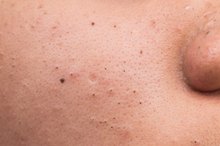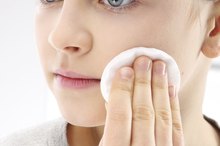Why Does Pus From Acne Have an Odor?
Acne is a common but complex, inflammatory skin disorder that affects at least 50 million American adults and adolescents, according to the American Academy of Dermatology 3. The inflammatory condition involves the oil glands of the skin, which become clogged with dead skin cells and excess oil, trapping bacteria in the pores. This triggers an inflammatory reaction and leads to the development of pimples, some of which contain pus. This pus can emit a foul odor due to the byproducts of bacteria feeding on skin oil.
Acne Bacteria
A type of bacteria called Propionibacterium acnes (P. acnes) normally lives deep in the oil-producing pores of the skin 4. P. acnes occupies this site because it feeds on skin oil, also known as sebum. People with acne typically have an overgrowth of P. acnes, likely due to excess sebum production. Those with acne also exhibit an exaggerated immune response to P. acnes, which leads to inflammation of the pores and an accumulation of white blood cells. The inflammatory response to the trapped bacteria along with an accumulation of sebum, dead skin cells and white blood cells within the pores leads to pus-filled pimples. In people with moderate to severe acne, these pimples can grow into larger nodules or cysts.
- A type of bacteria called Propionibacterium acnes (P. acnes) normally lives deep in the oil-producing pores of the skin 4.
- Those with acne also exhibit an exaggerated immune response to P. acnes, which leads to inflammation of the pores and an accumulation of white blood cells.
Bacteria-Related Odor
What Is the Difference Between Clogged Pores & Acne?
Learn More
Many types of bacteria emit odors as they grow. These odors arise from byproducts produced as the bacteria feed on various substances. P. acnes possesses specialized enzymes that enable the bacteria to breakdown and feed on sebum. This breakdown leads to formation of propionic acid and chemicals called short-chain fatty acids 6. While sebum is odorless, the byproducts of P. acnes breakdown of skin oil emit an odor that has been described as rancid or sour-smelling, similar to body odor.
- Many types of bacteria emit odors as they grow.
- While sebum is odorless, the byproducts of P. acnes breakdown of skin oil emit an odor that has been described as rancid or sour-smelling, similar to body odor.
Acne Pus Odor
When a small acne pimple breaks open and releases a minute amount of pus, it's unlikely you'll notice any odor. The amount of odor-emitting chemicals is typically too low to cause a noticeable odor. However, because larger acne nodules and cysts contain a greater volumes of pus and bacterial debris, you might briefly notice an odor when they drain. Gently washing away the pus with a mild skin cleanser and water will eliminate this temporary odor.
- When a small acne pimple breaks open and releases a minute amount of pus, it's unlikely you'll notice any odor.
Effect of Treatment
PH Effects on Skin
Learn More
Most recommended acne treatments either directly or indirectly reduce the overgrowth of P. acnes in the oil glands, thereby diminishing the likelihood of foul-smelling pus. Topical benzoyl peroxide products, for example, kill some of the P. acnes on the skin. These products are recommended, either alone or in combination with other acne treatments, by both the American Academy of Dermatology (AAD) and the American Academy of Pediatrics (AAP) 3. Topical or oral antibiotic therapy also reduces the population of P. acnes and is recommended for some people with acne. Topical retinoids -- such as tretinoin (Retin-A), adapalene (Differin) and tazarotene (Tazorac) cream, gel or lotion -- do not possess antibacterial properties, but help reduce P. acnes overgrowth indirectly.
Acne is not a life-threatening condition, but it can wreak havoc on your self-esteem and social life. See your doctor if you're living with persistent acne, especially if it is causing large pustules or cysts, which can lead to permanent scarring. Your doctor can assess your situation to determine whether you have acne or another skin condition that resembles acne, such as rosacea or folliculitis. If your doctor confirms a diagnosis of acne, she can then advise you about the best treatment options to manage your condition.
Reviewed and revised by: Tina M. St. John, M.D.
- Acne is not a life-threatening condition, but it can wreak havoc on your self-esteem and social life.
- See your doctor if you're living with persistent acne, especially if it is causing large pustules or cysts, which can lead to permanent scarring.
Related Articles
References
- Journal of Bacteriology: Complete Genome Sequence of Propionibacterium acnesType IB Strain 6609
- Pediatrics: Evidence-Based Recommendations for the Diagnosis and Treatment of Pediatric Acne
- Journal of the American Academy of Dermatology: Guidelines of Care for the Management of Acne Vulgaris
- Science of Acne: What is Propionibacterium acnes?
- Essential Microbiology, 2nd Edition; Stuart Hogg
- PubChem: Propionic Acid
- Endly DC, Miller RA. Oily Skin: A review of Treatment Options. J Clin Aesthet Dermatol. 2017;10(8):49-55.
- Kang JH. Febrile Illness with Skin Rashes. Infect Chemother. 2015;47(3):155-66. doi:10.3947/ic.2015.47.3.155
- "Questions and Answers About Acne." National Institute of Arthritis and Musculoskeletal and Skin Diseases (NIAMS). Jan 2006. National Institutes of Health.
- Eichenfield LF, Krakowski AC, Piggott C, et al. "Evidence-Based Recommendations for the Diagnosis and Treatment of Pediatric Acne." Pediatrics. 2013; 131: S163.
- Whitney KM, Ditre CM. "Management Strategies for Acne Vulgaris." Clinical Cosmetic and Investigational Dermatology. 2011; 4:41-53.
- Zaenglein AL, Pathy AL, Schlosser BJ, Alikhan A, Baldwin HE, et. al. "Guidelines of Care for the Management of Acne Vulgaris." Journal of the American Academy of Dermatology. 2016; 74(5): 945-73.
Writer Bio
Amanda Herron is a photojournalist and writer whose credits include: "Georgia Realtor Magazine," "Jackson Parent Magazine," "Christian Guitarist and Bassist" and the Associated Press. Herron has a Bachelor of Arts in journalism and a Master of Arts in Education from Union University. She is a member of the NPPA and has awards from the Tennessee Press Association and Baptist Press.









